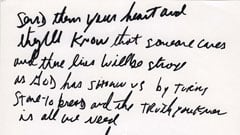Ever since Michael Jackson’s death, people have been looking for keys that might unlock the pop singer’s enigmatic persona. Why was Jackson so vulnerable to the impact of fame? Was he really a child trapped in a man’s body, or just misunderstood? Perhaps an examination of his handwriting—an extraordinary specimen—can provide some clues to how his mind worked.

Courtesy of Autograph Magazine and GottaHaveIt.com. All rights reserved.
This sample, written in the 1990s, contains the handwritten lyrics to the song, “We are the World,” which was written when Jackson was in his 30s. The mixing of upper- and lower-case letters shows confusion regarding his identity and could be the writing of a teenager. The movement, form, and space are weak, and the letters are narrow, which indicates introversion. The writing style is both slack and contracted, and the letters drift. A further lack of maturity is seen by the confusion of space and inconsistency in the size of the letters. The sloping baseline indicates melancholy, disillusion, and loss of innocence.
His baseline (a measurement of emotional stability) is constantly shifting.
This sample is replete with spelling errors, and the lack of punctuation and organization represents an almost free-association thought process. This could be due to having an incomplete education (as child stars often have) or a rebellious disregard for norms, including the norms of proper grammar and spelling.
Interestingly, the unique and original letter formations denote intelligence and creativity, and the slow, carefully written writing indicates that Jackson is a perfectionist who wishes to communicate on his own terms, unconventional though they may be. This reflects his unique and totally original lens on the interpretation of his thought process and the world around him.
The entire space picture is uneven. The size and zones of the letters change, as if the lines were a roadmap that rambles to nowhere. The baseline (a measurement of emotional stability) is constantly shifting, reflecting strong mood swings. The slant is variable and upright, possibly a stay against inner chaos and a search for an identity.
The t-crosses move to the right, representing future challenges. These t-crosses are often off the stem, showing he is always thinking of ways to behave, perform, and think differently. Jackson’s inner theater was filled with creative fantasy, which seemed to constantly renew itself.
The strong movement to the right, combined with the narrowness of the letters, show his emotional inhibitions despite his over-the-top behavior. Because everything is written in a state of flux and flow, the balance shifts—a further sign that he does not understand himself and does not find it easy to be understood by others. The lines are falling toward the bottom of the page, showing his fatigue, sadness, and search for meaning.
And although he has an unevenly developed spirit of savvy and an often-childlike manner, he is quick to make adjustments. Highly impulsive, he walks on a fine tightrope of feeling, reaching out and, at the same time, finding new ways to hide out at the expense of his authentic identity.
Arlyn Imberman is a professional graphologist and founder of Emerging Image, Inc. Her book, Signature for Success, was published last year.





